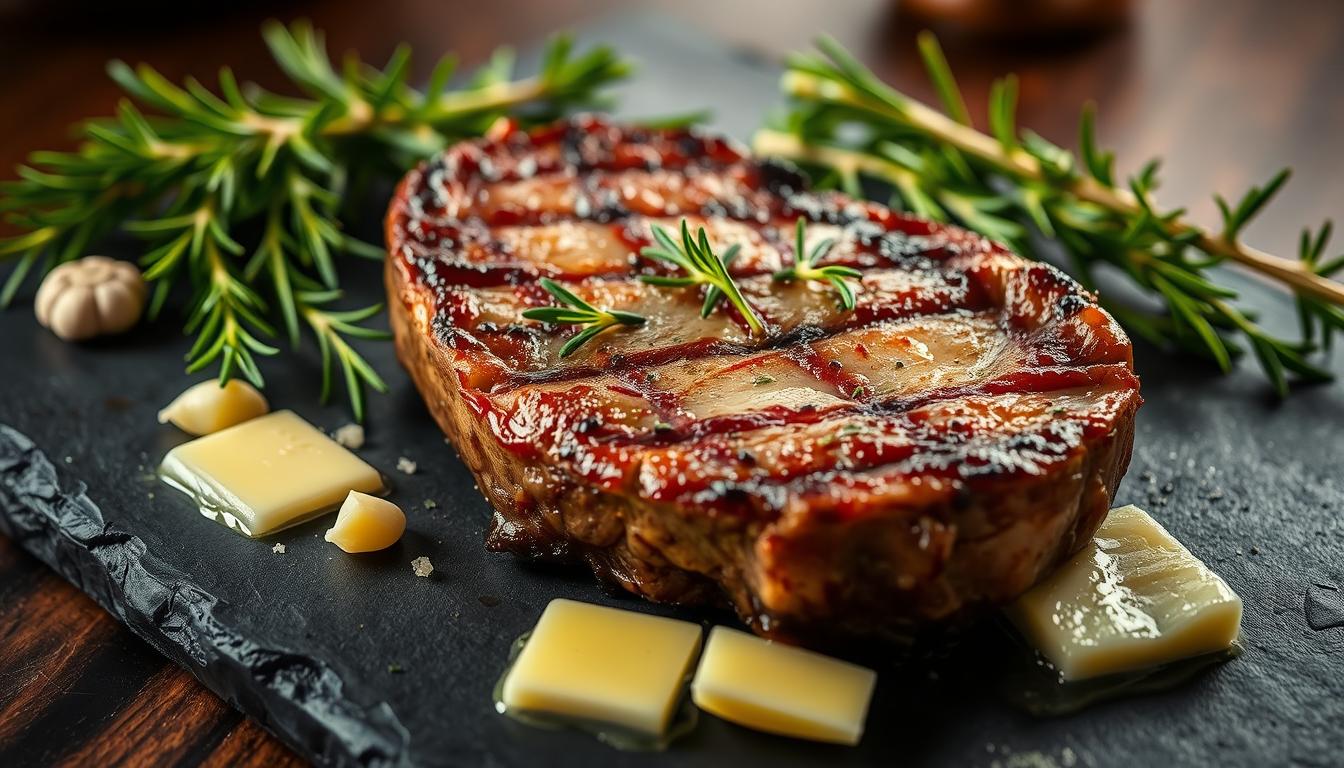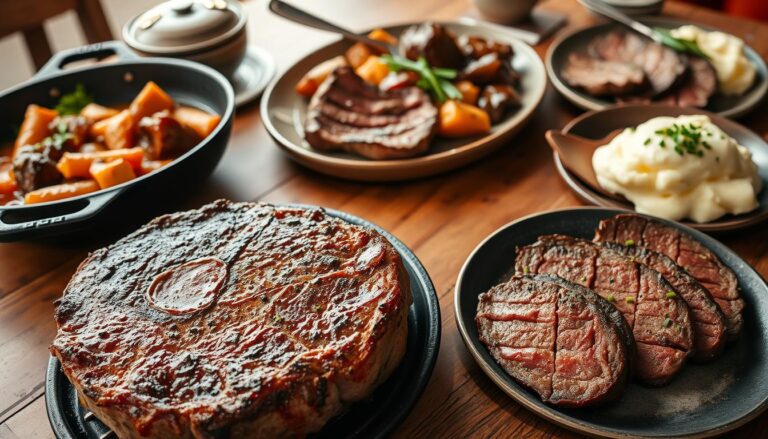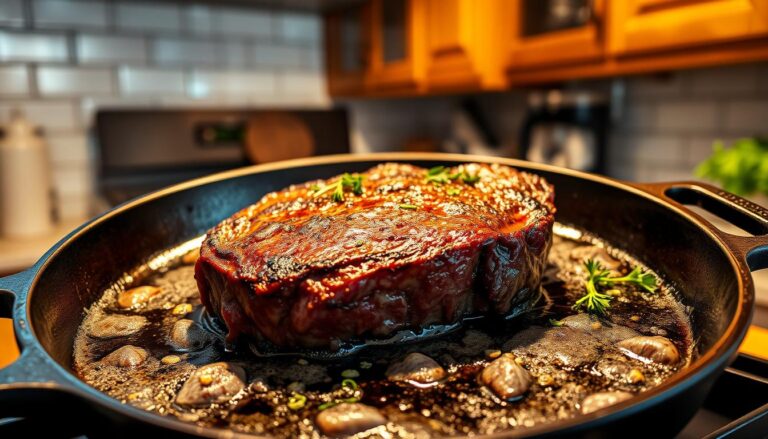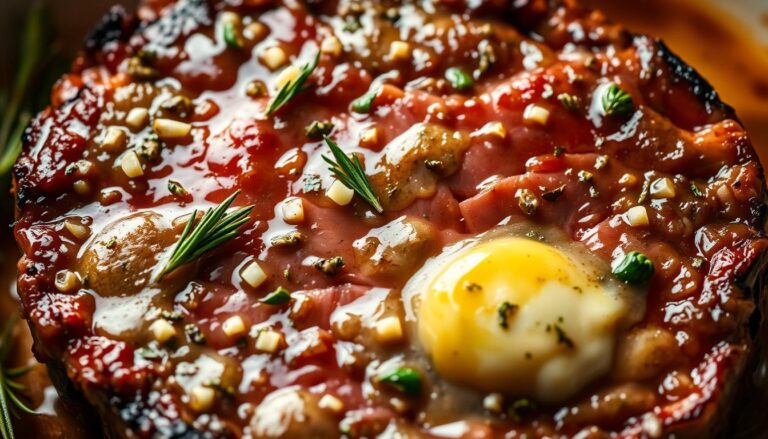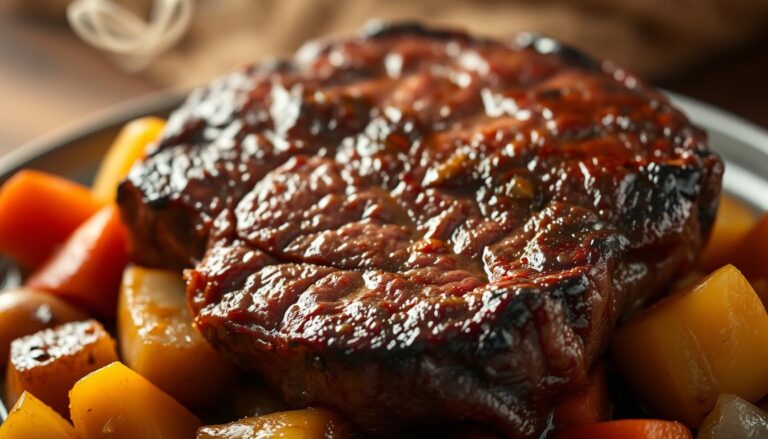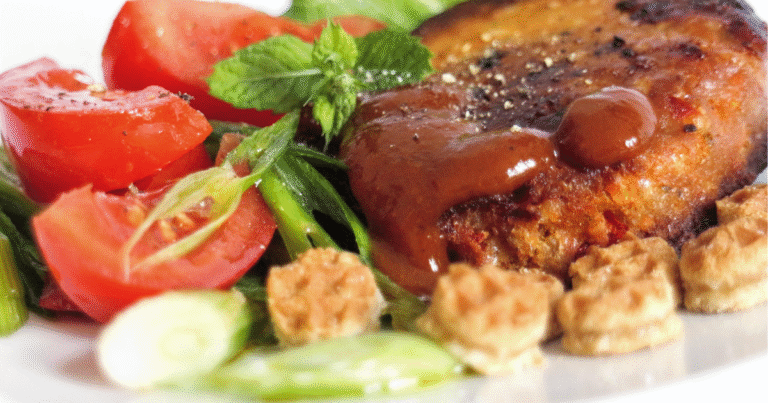Discover the Best Top Round Steaks for Flavorful Meals
There’s something magical about transforming simple ingredients into a meal that feels like a celebration. Picture this: a sizzling skillet, golden garlic butter melting over perfectly seared meat, and the aroma filling your kitchen like a warm hug. That’s the power of mastering a great cut like top round steak a budget-friendly choice that’s ready to shine with the right approach.
Choosing the right cut matters. A well-prepared top round steak delivers tenderness and rich flavor, rivaling pricier options. This guide unlocks secrets to restaurant-quality results at home, from selecting fresh, marbled meat to balancing time-saving techniques with foolproof methods.
You’ll learn how a hot skillet and aromatic herbs create a caramelized crust, while resting the meat ensures juicy slices every time. We’ve distilled tips from trusted chefs and home cooks, so you can skip the guesswork and focus on savoring the process and the meal.
Table of Contents
Understanding Top Round Steaks and Their Benefits
Ever wonder why some beef dishes taste richer while others stay tender on a tight budget? The answer lies in knowing your cuts. Meat from the cow’s hind legs offers three distinct options, each with unique traits that shape your cooking results.
What Makes This Top Round Steaks Special?
The lean yet flavorful option from the upper hind leg delivers balanced texture. Its moderate marbling allows it to absorb marinades beautifully while staying tender when cooked properly. Think of it as your go-to for quick dinners that don’t skimp on satisfaction.
Breaking Down the Differences
Here’s how the three main hind leg cuts stack up:
| Cut | Texture | Best For |
|---|---|---|
| Top Section | Most tender | Pan-searing, stir-fries |
| Bottom Section | Firmer | Slow cooking, braising |
| Eye Section | Leanest | Thin slicing, sandwiches |
The top option wins hearts for its versatility sear it hot and fast, or let it simmer in sauces. Bottom cuts need longer cooking but reward patience with deep flavor. Eye pieces work best when sliced thin against the grain.
Why does this matter? Choosing wisely means turning affordable beef into meals that feel indulgent. Whether you’re meal-prepping or hosting friends, these insights help you maximize flavor without overspending.
Selecting the Perfect Cut for Your Meal
Your dish starts long before the skillet heats up it begins at the meat counter. Quality matters here more than you might think. Look for cuts with a bright cherry-red hue, which signals freshness. Avoid grayish tones or excessive liquid in the packaging.
Tips for Finding Quality Meat
Trusted butchers often provide better marbling details than pre-packaged options. Moderate fat distribution is key too little makes meat tough, while thick streaks won’t melt properly during cooking. For recipes requiring quick searing, choose thinner slices (½-inch thick) to ensure even doneness.
Seasoning precision matters. A teaspoon of garlic powder per pound enhances flavor without overpowering. Pair this with kosher salt applied 40 minutes before cooking—it penetrates deeper than table salt.
| Store vs. Butcher | Price | Customization | Quality |
|---|---|---|---|
| Grocery Store | Lower | Limited | Variable |
| Local Butcher | Higher | Tailored thickness | Consistent |
Need meal-specific cuts? Ask butchers for “London broil” cuts if braising, or request ¼-inch slices for stir-fries. Pre-packaged meat works for simple recipes, but custom cuts give you control over texture and cooking time.
Essential Ingredients and Seasonings for Flavorful Results
Great meals start with great ingredients especially when working with leaner cuts. The right combination of seasonings transforms simple dishes into memorable experiences. Let’s break down what really matters in your spice cabinet.
Herbs, Spices, and Marinades
Garlic and pepper form the backbone of bold flavors. Fresh garlic cloves release aromatic oils when crushed, while coarsely ground black pepper adds texture and heat. Combine them with olive oil to create a base marinade that tenderizes meat and locks in moisture.
Onions play a subtle but powerful role. Thinly sliced and caramelized, they add natural sweetness to pan sauces. Try this herb blend for marinades:
- Rosemary + thyme for earthy depth
- Smoked paprika + cumin for warmth
- Oregano + lemon zest for brightness
| Fresh Herbs | Dried Herbs | Best Uses |
|---|---|---|
| Basil | Marjoram | Quick marinades |
| Parsley | Bay leaves | Slow-cooked sauces |
Using Salt, Pepper, and Garlic Effectively
Kosher salt’s coarse grains adhere better than table salt, seasoning meat evenly. Apply it 30 minutes before cooking to draw out natural juices. “Pepper isn’t just heat it’s aroma,” says Chef Laura Bennett. Always grind fresh peppercorns to preserve their volatile oils.
For garlic, minced cloves work best in marinades, while roasted bulbs blend smoothly into sauces. Olive oil prevents sticking and helps spices cling to the meat’s surface. Finish with a pan sauce using caramelized onions, beef broth, and a splash of red wine for restaurant-worthy depth.
Step-by-Step Guide to Cooking Top Round Steaks
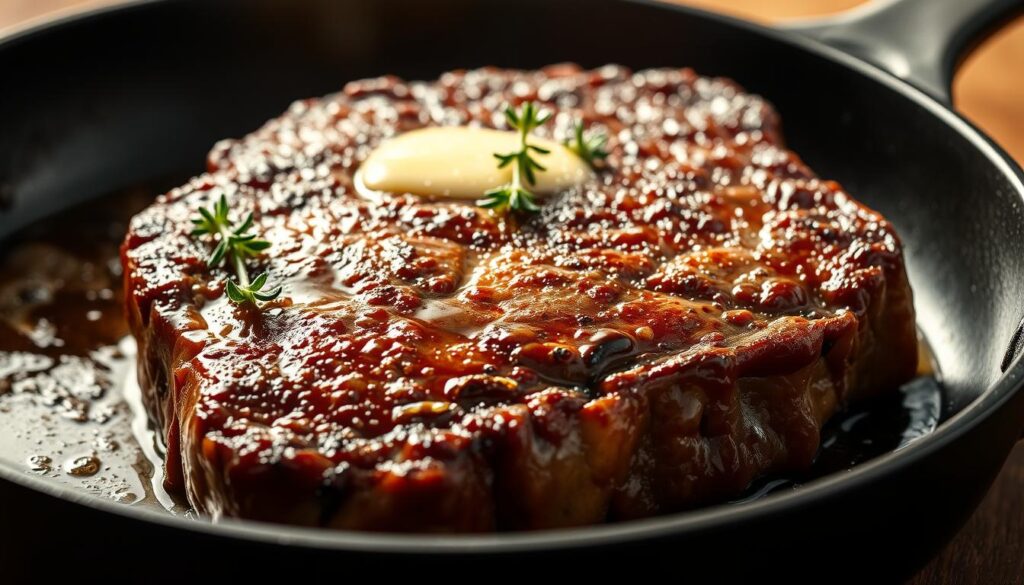
Mastering the art of cooking beef starts with technique, not mystery. Follow this roadmap to transform your kitchen into a steakhouse without the guesswork.
Tenderizing and Marinating Techniques
Begin with a meat mallet or jaccard tool. Gently pound thicker areas to even out your cut. This creates tiny channels for marinades to penetrate deeper.
- Mix ¼ cup olive oil, 3 crushed garlic cloves, and 1 tbsp lemon juice
- Rub mixture onto both sides of the meat
- Let rest in the fridge for 45 minutes (never exceed 2 hours)
Why it works: Acidic components like citrus break down tough fibers while oil carries flavors inward. Always pat meat dry before cooking to ensure proper searing.
Searing and Basting Methods
Heat your skillet until water droplets dance on its surface. Add 1 tbsp high-smoke-point oil. Carefully lay the meat in the pan, it should sizzle immediately.
- Sear 3-4 minutes per side for medium-rare
- Tilt pan and spoon melted herb butter over the meat repeatedly
- Transfer to a warm plate for 7-8 minutes before slicing
Chef’s secret: Basting with butter during the last 90 seconds creates a flavor-packed crust. Letting the meat rest redistributes juices cut too soon, and they’ll spill onto your board.
This approach works across various steak recipes. Adjust cooking minutes by thickness: add 60 seconds per ¼ inch for well-done preferences. Always slice against the grain for maximum tenderness.
Mastering Top Round Steaks with Versatile Cooking Methods
Your kitchen becomes a playground when you explore different ways to unlock flavor. Whether you crave smoky char or melt-in-your-mouth tenderness, the right method transforms your meal. Let’s break down how heat and timing work together.
Pan-Searing for Speed and Crust
A blazing-hot skillet creates that golden crust foodies love. Preheat your pan until oil shimmers—this ensures even contact. Sear 3 minutes per side, then baste with garlic butter. Perfect for weeknights when time matters.
Low-and-Slow Alternatives
Oven roasting at 275°F for 90 minutes yields fork-tender meat. Wrap your cut in foil with broth and herbs. Slow cooker methods shine for busy days—set it on low for 6 hours with onions and spices.
| Method | Texture | Best Use |
|---|---|---|
| Pan-Sear | Crispy exterior | Quick dinners |
| Oven | Uniform doneness | Meal prep |
| Slow Cooker | Pull-apart soft | Busy schedules |
Grilling over charcoal adds smoky depth. For London broil, marinate overnight and slice thin. Air fryers deliver crisp edges in 12 minutes ideal for single servings. Match your tools to your goals: use high heat for bold flavor or gentle heat for convenience.
Ground spices like cumin or paprika form quick rubs. Always preheat equipment cold surfaces toughen meat. Experiment to find your favorite way. Your next masterpiece awaits!
Tips and Tricks for Enhancing Steak Flavor
What if your next steak could taste completely new without changing the cut? Seasoning holds that power. A pinch of creativity transforms familiar flavors into exciting experiences, turning weeknight dinners into culinary adventures.
Think beyond salt and pepper. Bold blends like smoked paprika or coffee rubs add depth, while citrus zest brightens rich flavors. Your spice cabinet is a treasure chest—time to explore it.
Breaking the Flavor Mold
Try these tested combinations for instant upgrades:
| Seasoning Blend | Flavor Profile | Best For | Heat Level |
|---|---|---|---|
| Garlic Herb | Savory, aromatic | Pan-seared cuts | Mild |
| Smoky Chipotle | Earthy, bold | Grilled preparations | Medium |
| Coffee Cocoa Rub | Rich, slightly sweet | Oven-roasted dishes | Low |
Montreal steak seasoning brings peppery warmth, while Cajun spice delivers a kick. For Asian-inspired twists, mix ginger, sesame oil, and five-spice powder. “The best rubs balance three elements: saltiness, sweetness, and heat,” notes grill master Carlos Mendez.
Marinades work magic too. Combine soy sauce, brown sugar, and lime juice for tangy tenderness. Let meat soak 30 minutes no longer, or textures turn mushy. Dry brines (salt + sugar rubs) create crispy crusts when searing.
Your turn: Start with small batches. Mix 1 tsp of an unfamiliar spice into your usual blend. Taste as you go. Remember—flavor layers build gradually. One bold shake can redefine your entire dish.
Pairing Your Steak with Classic Sides and Sauces
A perfectly cooked cut deserves companions that elevate every bite. The right sides don’t just fill the plate—they create harmony, turning individual elements into a memorable meal.
Balancing Textures and Flavors
Creamy mashed potatoes act as a velvety counterpoint to savory beef. Their mild richness absorbs pan juices without competing for attention. Use Yukon Gold potatoes for natural buttery notes—their starch content ensures smooth, lump-free results.
Onion gravy ties everything together. Simmer caramelized onions with beef broth and a splash of Worcestershire sauce for depth. “A great gravy amplifies the meat’s flavor while adding moisture to leaner cuts,” explains Chef Marcus Green. Drizzle it over both the steak and potatoes for cohesive flavor.
Keep sides simple to let the main dish shine. Roasted carrots or garlic spinach add color without overwhelming the palate. For family dinners, serve components in shared bowls to encourage mixing flavors on each plate.
| Side Dish | Prep Time | Flavor Role |
|---|---|---|
| Mashed Potatoes | 25 mins | Neutral base |
| Onion Gravy | 15 mins | Umami boost |
| Green Beans | 10 mins | Fresh contrast |
Portion sizes matter: aim for ½ cup of potatoes and ¼ cup gravy per serving. These ratios ensure every forkful delivers balanced taste and texture. Classic pairings endure because they work—stick with them for guaranteed crowd appeal.
Adapting Your Technique for Budget-Friendly Beef Dinners
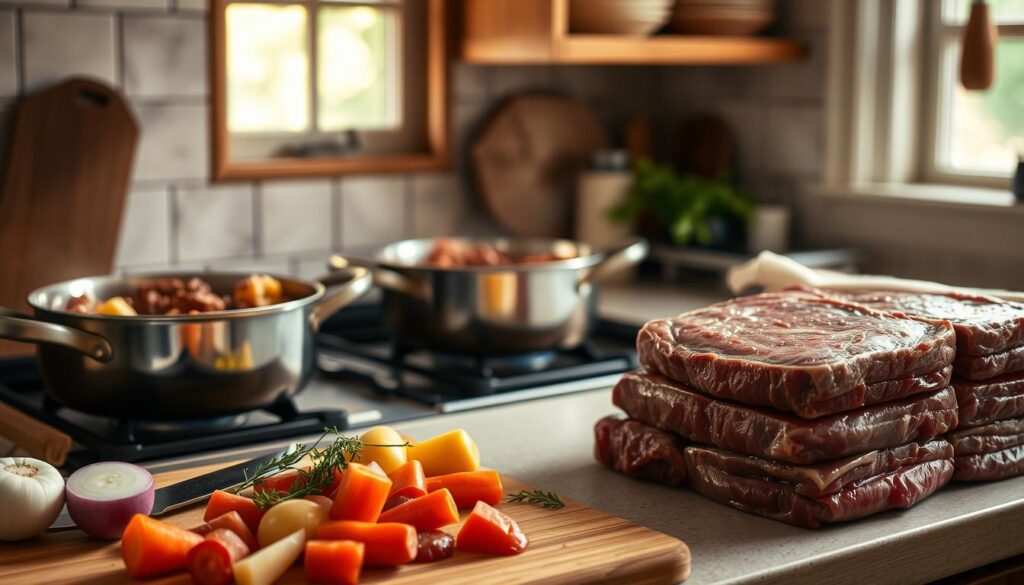
Eating well on a budget doesn’t mean sacrificing flavor—especially when you know how to maximize affordable cuts. Lean, versatile options from the hind leg deliver rich taste without premium prices. “You can create steakhouse-quality meals for half the cost,” shares home cook Marissa Torres, who feeds her family of five weekly using these strategies.
Start at the grocery store. Look for value packs labeled “family size” or “manager’s special.” These often cost 20% less per pound. Pro tip: Freeze individual portions in airtight bags for later use. Local butchers may offer discounts on larger orders ask about bulk pricing for roasts you can slice at home.
| Source | Cost Per Pound | Customization | Best For |
|---|---|---|---|
| Supermarket Sales | $4.99-$6.99 | Pre-cut portions | Quick meals |
| Butcher Bulk Orders | $3.50-$5.50 | Thickness preferences | Meal prepping |
Stretch ingredients without skimping. Dice cooked beef into stir-fries or tacos—½ pound easily serves four when paired with beans and veggies. Simmer tougher pieces in broth for soups, transforming them into fork-tender bites. Marinades work double duty, adding flavor while tenderizing economical cuts.
Jessica Lin, a meal-planning blogger, swears by this approach: “I buy one large roast, slice it thin for fajitas, cube some for stews, and grind the rest for burgers. Three meals from one purchase!” Pair with seasonal produce and pantry staples like rice or potatoes for balanced plates that keep everyone satisfied.
Conclusion
Mastering beef dishes begins with understanding your ingredients and trusting your skills. You’ve learned how selecting well-marbled cuts from the cow’s hind leg lays the foundation, whether working with lean eye sections or hearty bottom pieces. The right techniques like hot pan searing or slow braising unlock tenderness in every bite.
Remember, even tougher cuts transform with proper seasoning and patience. A simple garlic rub or caramelized onion gravy elevates budget-friendly pieces into memorable meals. Keep this guide handy for round steak recipes that adapt to your schedule quick skillet dinners or weekend projects.
Each part of the animal offers unique possibilities. Thinly sliced eye sections shine in sandwiches, while bottom cuts become fork-tender in stews. Your pan, oven, or slow cooker becomes a tool for creativity.
Now it’s your turn. Grab those ingredients, trust the process, and savor the rich flavor of your efforts. Every meal is a chance to refine your craft one delicious slice at a time.
FAQ
How does top round differ from bottom round or eye round?
Top round comes from the upper hind leg, offering a leaner texture ideal for roasting or slicing. Bottom round is tougher and often used for slow-cooking, while eye round is smaller and best for thin cuts like deli meat.
What should I look for when buying this cut at the grocery store?
Choose bright red meat with minimal fat marbling and a firm texture. Look for USDA Choice or Prime grades for tenderness, and avoid packages with excess liquid.
Can marinades make a difference in tenderness?
Yes! Acidic ingredients like vinegar or citrus break down fibers, while olive oil and garlic add moisture. Marinate for at least 4–6 hours for optimal results.
What’s the best way to cook this cut without drying it out?
Sear it quickly in a hot skillet to lock in juices, then finish in a 325°F oven. Use a meat thermometer to pull it at 130–135°F for medium-rare, and let it rest before slicing.
Can I use a slow cooker for recipes?
Absolutely. Slow-cooking with broth or wine at low heat for 6–8 hours tenderizes the meat, making it perfect for shredded beef dishes or hearty stews.
What sides pair well with these meals?
Creamy mashed potatoes, roasted vegetables, or onion gravy complement the rich flavors. For lighter options, try a crisp green salad or garlic sautéed greens.
How can I make budget-friendly dinners with this cut?
Slice thinly for stir-fries, cube for kebabs, or braise with affordable veggies. Buying larger cuts on sale and freezing portions also helps reduce costs.

